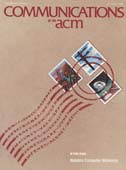October 1986 - Vol. 29 No. 10

Features
Computer networks are becoming more numerous and more diverse. Collectively, they constitute a worldwide metanetwork.
Presented here is the Computer Science Board's survey on the production and employment of Ph.D.'s and faculty in computer science and engineering.
Microprocessor architectures: a comparison based on code generation by compiler
By carefully tuning computer and compiler, it is possible to avoid the otherwise inevitable compromises between complex compiling algorithms and less-than-optimal compiled code, where the key to performance appears to lie neither in sophisticated nor drastically reduced architectures, but in the key concepts of regularity and completeness.
Accessing bit fields in FORTRAN-77
By incorporating bit-manipulation routines into Fortran-77, it is now possible to manipulate bits or partial word operands without having to write assembly-coded subroutines. Because the routines are now acceptable to Fortran-77 compilers, the accessing code is now portable to other Fortran Machines.
Min-max heaps and generalized priority queues
A simple implementation of double-ended priority queues is presented. The proposed structure, called a min-max heap, can be built in linear time; in contrast to conventional heaps, it allows both FindMin and FindMax to be performed in constant time; Insert, DeleteMin, and DeleteMax operations can be performed in logarithmic time. Min-max heaps can be generalized to support other similar order-statistics operations efficiently (e.g., constant time FindMedian and logarithmic time DeleteMedian); furthermore, the notion of min-max ordering can be extended to other heap-ordered structures, such as leftist trees.



